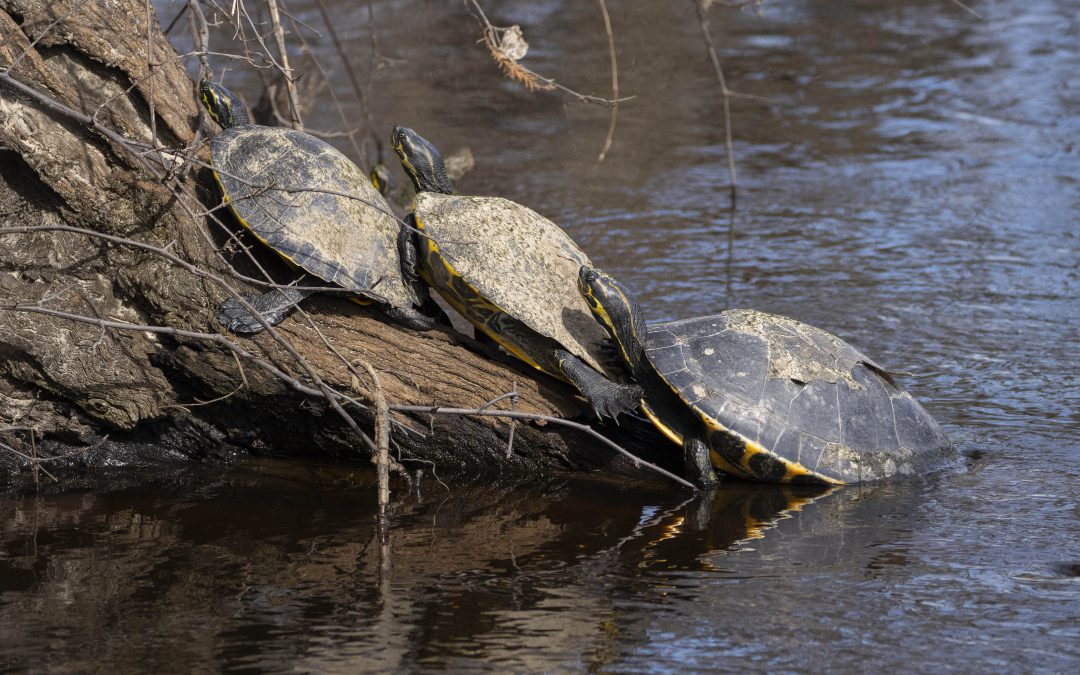
by Rick O'Connor | May 13, 2022
The Florida panhandle has one of rich biodiversity. This goes for the variety of turtles found here as well. Many paddlers and hikers to our waterways see these turtles but have trouble identifying which they are looking. In response to request by outdoor adventures wanting to learn more, UF IFAS Extension will be offering a one day workshop on field identification of panhandle riverine turtles.
The workshop will be held this Monday – May 16, 2022 – in Apalachicola FL. Participants will attend a classroom session where the biogeography of our turtles will be discussed and visual identification will be practiced. We will then take a boat ride up the Apalachicola River and practice in the field.
The program will begin at 8:30am (ET) at the Franklin County Extension Office. The cost will be $25 and preregistration is required. You can register at https://riverine_turtles_florida_panhandle.eventbrite.com/
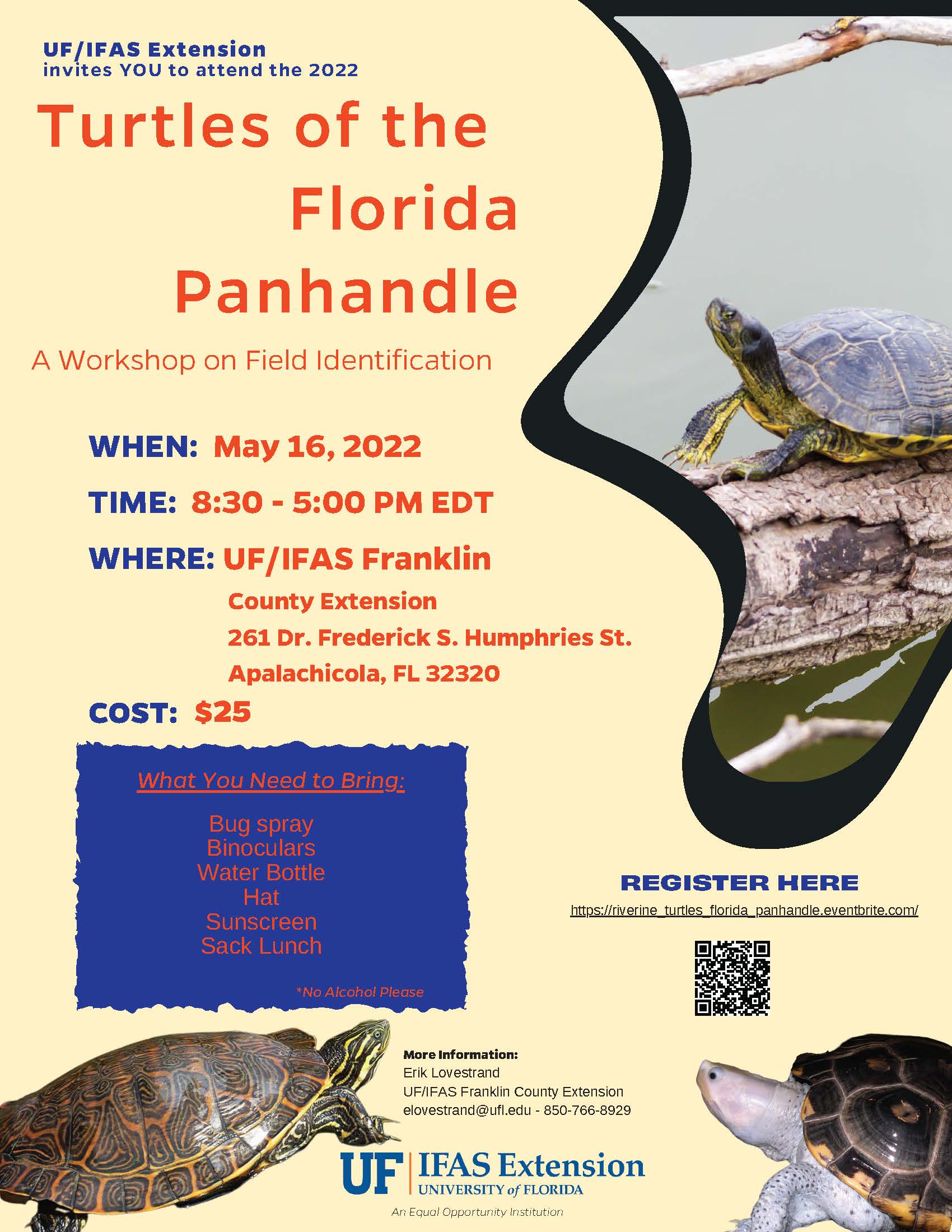

by Laura Tiu | May 13, 2022
The northwest Florida area has been identified as having the highest concentration of invasive lionfish in the world. Lionfish pose a significant threat to our native wildlife and habitat with spearfishing the primary means of control. Lionfish tournaments are one way to increase harvest of these invaders and help keep populations down. Not only that, but lionfish are a delicious tasting fish and tournaments help supply the local seafood markets with this unique offering.
Since 2019, Destin, Florida has been the site of the Emerald Coast Open (ECO), the largest lionfish tournament in the world. While the tournament was canceled in 2020, due to the pandemic, the 2021 tournament and the Lionfish Removal and Awareness Day festival returned to the Destin Harbor and led to the removal of over 10,000 invasive lionfish.
This weekend, May 14 and 15, 2022, the tournament and festival will be in back in full force at HarborWalk Village in Destin Harbor. A record number of teams will be on the water competing for cash prizes and other loot. Florida Sea Grant will be on hand to support the two-day festival that will include lionfish tasting and fillet demonstrations, conservation and art booths, interactive kids zone, shopping, and lionfish viewing! Bring your family and friends out to support this unique event and do your part to help fight invasive lionfish.
For more information on the tournament, visit EmeraldCoastOpen.com or Facebook.com/EmeraldCoastOpen.
For information about Lionfish Removal and Awareness Day, visit FWCReefRangers.com
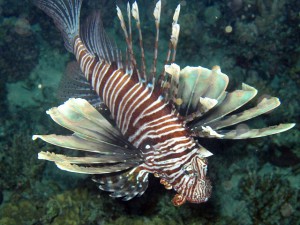
The Invasive Lionfish
“An Equal Opportunity Institution”

by Sheila Dunning | Jan 6, 2022
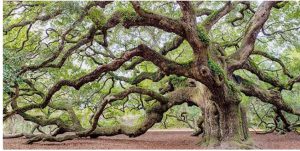
Old Live Oak
Picture from National Wildlife Foundation
The best time to plant a tree is twenty years ago. The second best time is Arbor Day. Florida recognizes the event on the third Friday in January, but planting any time before spring will establish a tree quickly.
Arbor Day is an annual observance that celebrates the role of trees in our lives and promotes tree planting and care. As a formal holiday, it was first observed on April 10, 1872 in the state of Nebraska. Today, every state and many countries join in the recognition of trees impact on people and the environment.
Trees are the longest living organisms on the planet and one of the earth’s greatest natural resources. They keep our air supply clean, reduce noise pollution, improve water quality, help prevent erosion, provide food and building materials, create shade, and help make our landscapes look beautiful. A single tree produces approximately 260 pounds of oxygen per year. That means two mature trees can supply enough oxygen annually to support a family of four.
The idea for Arbor Day in the U.S. began with Julius Sterling Morton. In 1854 he moved from Detroit to the area that is now the state of Nebraska. J. Sterling Morton was a journalist and nature lover who noticed that there were virtually no trees in Nebraska. He wrote and spoke about environmental stewardship and encouraged everyone to plant trees. Morton emphasized that trees were needed to act as windbreaks, to stabilize the soil, to provide shade, as well as fuel and building materials for the early pioneers to prosper in the developing state.
In 1872, The State Board of Agriculture accepted a resolution by J. Sterling Morton “to set aside one day to plant trees, both forest and fruit.” On April 10, 1872 one million trees were planted in Nebraska in honor of the first Arbor Day. Shortly after the 1872 observance, several other states passed legislation to observe Arbor Day. By 1920, 45 states and territories celebrated Arbor Day. Richard Nixon proclaimed the last Friday in April as National Arbor Day during his presidency in 1970.
Today, all 50 states in the U.S. have official Arbor Day, usually at a time of year that has the correct climatological conditions for planting trees. For Florida, the ideal tree planting time is January, so Florida’s Arbor Day is celebrated on the third Friday of the month. Similar events are observed throughout the world. In Israel it is the Tu B Shevat (New Year for Trees). Germany has Tag des Baumes. Japan and Korea celebrate an entire week in April. Even Iceland, one of the most treeless countries in the world observes Student’s Afforestation Day.
The trees planted on Arbor Day show a concern for future generations. The simple act of planting a tree represents a belief that the tree will grow and someday provide wood products, wildlife habitat, erosion control, shelter from wind and sun, beauty, and inspiration for ourselves and our children.
“It is well that you should celebrate your Arbor Day thoughtfully, for within your lifetime the nation’s need of trees will become serious. We of an older generation can get along with what we have, though with growing hardship; but in your full manhood and womanhood you will want what nature once so bountifully supplied and man so thoughtlessly destroyed; and because of that want you will reproach us, not for what we have used, but for what we have wasted.”
~Theodore Roosevelt, 1907 Arbor Day Message
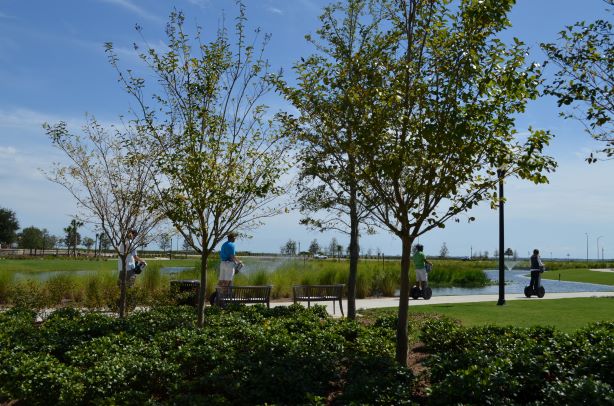
by Rick O'Connor | Apr 30, 2021
Please join us for a two-part webinar series ‘Managing Stormwater in a Changing Florida Panhandle’ on May 12th from 8-10 am CST (9-11 am EST), and May 19th from 8-10 am CST (9-11 am EST). The webinar series will cover stormwater management, green infrastructure and low impact development.
Please register through the following Eventbrite link: https://www.eventbrite.com/e/managing-stormwater-in-a-changing-florida-panhandle-tickets-150535308159
A detailed agenda can be found on the Eventbrite page.
- 4 Professional Development Hours (PDH) will be offered for Professional Engineers through the Florida Board of Professional Engineers. Two PDHs will be offered for Day 1 and two will be offered for Day 2.
- 4 Continuing Education Units (CEU) will be offered for Pesticide Applicators through FDACS in the following categories: Ornamental & Turf, Private Applicator Ag, Right-of-Way, Aquatic, Natural Areas, Commercial Lawn & Ornamental, Limited Commercial Landscape Maintenance, Limited Lawn & Ornamental and Limited Urban Fertilizer.
The webinar is free for those not seeking PDHs or CEUs. For those seeking PDHs or CEUs, the cost is $50 for Day 1, and $50 for Day 2.
We look forward to your attendance! Feel free to contact Dr. Andrea Albertin if you have any questions.
Dr. Andrea Albertin – (850) 875-7111 – albertin@ufl.edu
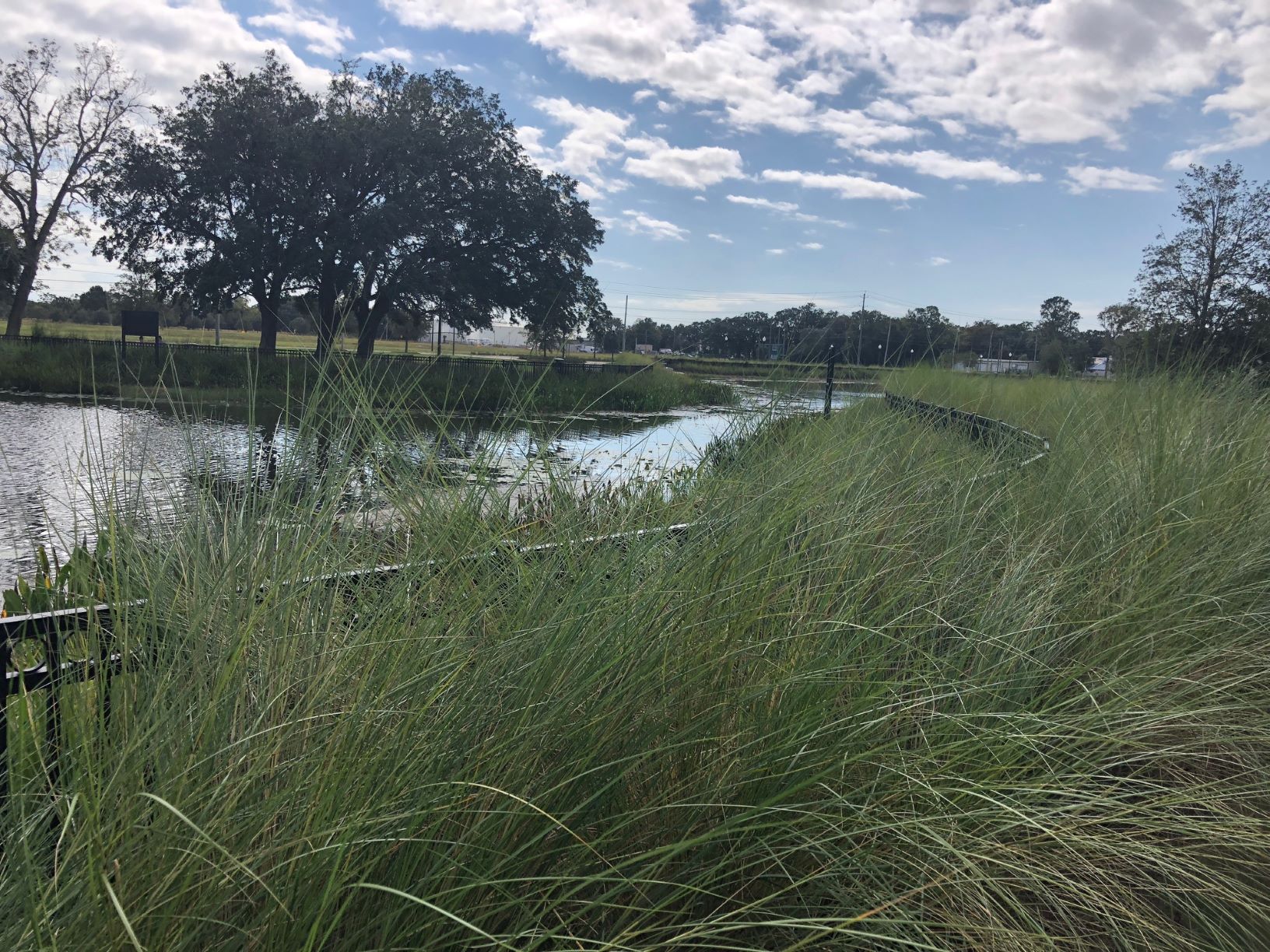
Well-maintained stormwater ponds can become attractive amenities that also improve water quality. Photo credit: Carrie Stevenson, UF IFAS Extension
by Carrie Stevenson | Jan 14, 2021
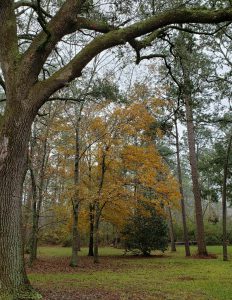
A healthy and diverse native forest provides many benefits for environmental and human health. Photo credit, Cathy Hardin
Trees often are low on priority lists – unless you had tree damage as a result of Hurricane Sally. However, you might be surprised to learn that trees played a beneficial, if somewhat behind the scenes, role for good this year and every year. And celebrating the good, while not ignoring potential problems, is important when making decisions involving trees.
Often trees are disparaged, especially after a severe storm. Many trees fell during Sally, causing costly clean up and often significant damage. Some trees were damaged: causing hazardous conditions, opportunities for the tree disease and insect infestation, or simply aesthetically unpleasant disfigurement. Even without storms, trees require care, can interfere with utilities and foundations, and require extra clean up certain times of year. Yet, healthy well-maintained trees might reduce wind speeds and damage for property underneath or on the leeward (downwind) side of trees. Trees also significantly reduce erosion and absorb stormwater.
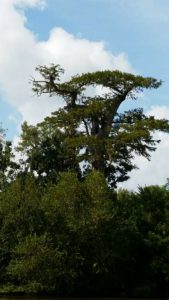
Bald cypress. Photo credit, Cathy Hardin
Trees often give more than they take. Many studies have been done on the effects of green space on a person’s well-being, including lowering blood pressure, speeding up recovery times, and lessening depression and anxiety. Other social benefits include lowering crime rates, increasing property values, creating beauty and space for recreation and relaxation, and lowering cooling bills. They provide habitat for birds and other wildlife. We haven’t even begun to mention the material benefits such as fruit, nuts, wood, and the 5,000 plus commercial products made from trees (wood, roots, leaves, and saps).
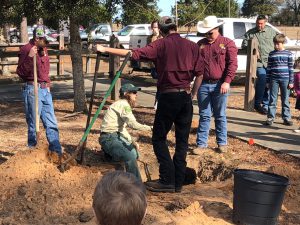
Author and county forester Cathy Hardin demonstrates proper tree planting at a past Arbor Day program. Photo credit: Carrie Stevenson, UF IFAS Extension
So, celebrate trees this year! Winter is a great time to improve existing trees and to plant new ones. Florida Arbor Day is celebrated the on the third Friday in January – January 15, 2021. National Arbor Day is the last Friday in April. In Escambia County, the UF IFAS Extension office is holding several Arbor Day related events, including a drive-through tree giveaway on January 23. Even if you are not able to attend a public event in your area, you still can get out and celebrate trees. Below are some ideas.
Existing Trees
• Care for storm damaged trees.
o Contact an arborist for evaluation of potential hazards
o Properly prune out broken limbs to create a smooth surface
o Some trees may not be able to be successfully treated and need removal
o Most trees will recover, but might need time and/or multiple treatments
• Learn about proper pruning techniques to take care of smaller trees yourself
• When hiring a professional is required, hire a reputable company with a certified arborist on staff. Ensure the company has both Personal and Property Damage Liability Insurance and Worker’s Compensation Insurance. Arborists certified by the International Society of Arboriculture can be found at http://www.isa-arbor.com/findanarborist/arboristsearch.aspx.
• Take care of tree roots. Don’t compact the soil by parking or piling things in the root zone. Use caution
when applying any chemicals (fertilizer, herbicide, pesticides) to the soil or lawn. Read the label to
ensure it will not harm your tree.
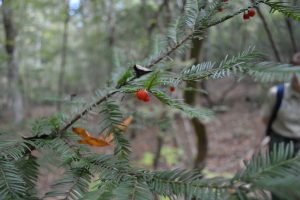
Florida yew. Photo credit, Cathy Hardin
New Plantings
• Decide what species of tree is right for you, considering the soil type, size of opening, climate, and eventual size of tree.
• Plant the tree at the right depth, not too deep or too shallow.
• Keep it simple. Soil amendments, fertilizers, and staking are usually unnecessary, especially for small native trees.
• Mulch lightly over the root zone, but not against the trunk.
• Water regularly until the tree is established. (Three gallons per inch of tree diameter weekly – applied slowly at the root ball)
• Celebrate!
• Take a photo of your favorite tree to post on social media. Tag the Florida Forest Service!
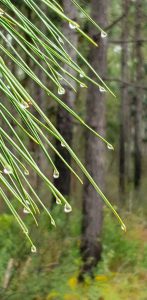
Longleaf pine. Photo credit, Cathy Hardin
• Take a hike in the woods or a nearby park.
• Have a picnic with friends or family by a tree.
• Be grateful for your tree and its benefits.
• Teach a child about trees. There are many activities that can be used. Check out Project Learning Tree Activities for Families – Project Learning Tree (plt.org) or the Arbor Day Foundation www.ArborDay.org for a few ideas.
• Plant a new tree.
For more information on the benefits of trees, visit healthytreeshealthylives.org or www.vibrantcitieslab.com. The Florida Forest Service, a division of the Florida Department of Agriculture and Consumer Services, manages more than 1 million acres of state forests and provides forest management assistance on more than 17 million acres of private and community forests. The Florida Forest Service is also responsible for protecting homes, forestland and natural resources from the devastating effects wildfire on more than 26 million acres. Learn more at FDACS.gov/FLForestService.
Cathy Hardin is the Escambia County Forester for the Florida Forest Service and can be reached at Cathy.Hardin@fdacs.gov.

by Carrie Stevenson | Jan 17, 2020
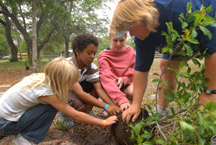
4H youth assist an IFAS Extension agent in planting a tree. UF/IFAS Photo: Josh Wickham.
This week, we celebrate Florida’s Arbor Day. “What?” you may say—“Isn’t Arbor Day in the spring?” Well, yes and no. National Arbor Day is celebrated in the spring (April 24 this year), usually within a day or two of Earth Day. However, because of the wide range of climatic environments throughout the United States, each state has its own date based on ideal growing conditions. As it stands, Florida’s is the 3rd Friday in January, as we are situated so very far south. Alabama and Georgia, where so many of us north Floridians experience similar weather, hold their Arbor Days in late February.
Contrary to popular opinion, the optimal planting time for trees in not in the spring, but in fall and winter. Planting during dormancy allows trees to focus their energy resources on growing healthy roots. In the coming spread, a steady supply of warmth, sunshine, and pollinators bring on leaf growth, flowers, and fruit.
Check with your local Extension offices, garden clubs, and municipalities to find out if there is an Arbor Day event near you! Several local agencies have joined forces to organize tree giveaway and sales events in observance of Florida’s Arbor Day.
Friday, January 17th
Okaloosa County: UF/IFAS Okaloosa County, in partnership with the Florida Forest Service, the Niceville Senior Center and the Kiwanis Club of Niceville-Valparaiso, will give away trees beginning at 9 a.m., until all trees are gone. Niceville Senior Center, 201 Campbell Drive. A UF/IFAS Extension agent will conduct a tree planting demonstration and UF/IFAS Master Gardener volunteers will be available to answer questions about planting and growing trees in North Florida.
Saturday, January 18th
Walton County Master Gardener Volunteer Tree and Plant Sale
A wide variety of plants and trees will be offered: shade trees, ornamentals, citrus, flowering, tropical, fruits, nuts, berries, shrubs, grasses, vines, palms, and ferns.
Time: 9 a.m. to noon
UF/IFAS Extension Walton County
DeFuniak Springs, FL
Escambia County: UF/IFAS Extension Escambia County is partnering with the Escambia County Water Quality and Land Management Department and the Florida Forest Service for the annual Tree Giveaway. Events begin with a tree planting demonstration at 8:45 and conclude by noon (or until the trees are all distributed, two per household). Beulah Middle School, 6001 Nine Mile Road, Pensacola.
Jackson County: Tree give-away Saturday, January 18 at 9 am at Florida Forest Service work center at 3973 Kynesville Rd, Marianna
Wakulla County: UF/IFAS Wakulla County Master Gardeners are hosting a tree giveaway.
Saturday, January 25th
Leon County: UF/IFAS Extension Leon County Master Gardeners will assist with the county’s Arbor Day tree planting at 9 a.m. Martha Wellman Park, 5317 W. Tennessee St., Tallahassee.















